The modern (and modern) Republic of Poland - the land of milk, honey and tolerance flowing. This image of 16th and 17th-century Poland, free from religious persecution, the crimes of the inquisition and witch trials, is promoted to this day. But have there never been any burning piles on the Vistula?
In the fifteenth century, when mass fires began to be lit in Western Europe under the feet of people suspected of witchcraft and dealing with the devil, few people in the Commonwealth of similar superstitions had yet heard. Even if they did, the alleged witches were treated rather indulgently. Hence, there are virtually no victims of brutal executions at the stake. This state of affairs did not last forever.
A Polish historian dealing with the history of witchcraft trials in old Poland, Bohdan Baranowski, emphasized that "at the turn of the 16th and 17th centuries, a new type of witchcraft trial appeared in Poland, strictly following German patterns. Trials related to the person of the devil were no longer held before church courts, but secular, most often municipal courts. " It was then that the highest punishment for practicing magic began.
According to the researcher, from the 16th to the 18th century in the territory of the present-day Polish state, there were as many as 20-40,000 victims of witch hunts . Nowadays, these calculations are considered to be definitely exaggerated, which, however, is not tantamount to the claim that there are no piles in our country at all. So how many lives has been consumed by belief in superstition?
The witch in front of the court
Most likely, the first case of a death sentence against an alleged witch was the case of a woman from Chwaliszewo near Poznań. In 1511, she paid with her head for destroying several breweries by magic and exposing their owners to considerable material damage. Over time, similar processes began to multiply.
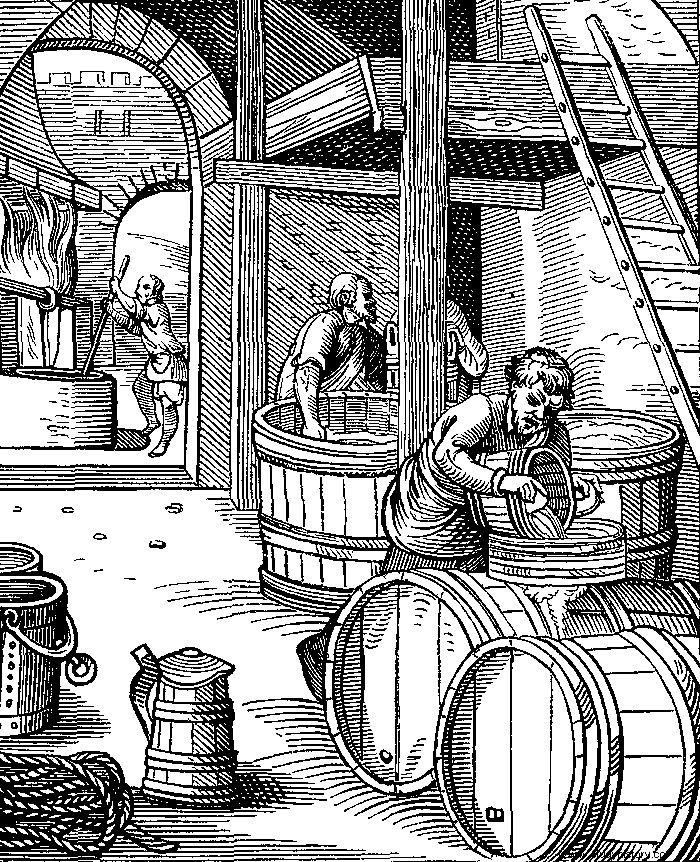
The "witch" from Chwaliszewo near Poznań was put on the stake in 1511 for allegedly destroying several breweries with charms.
What threatened the convicted person (because there were also men among the suspects)? Maciej Liziniewicz describes the course of a "typical" execution in a suggestive way in his latest historical novel "Czas vengeance":
Having grabbed the witch, the crowd started dragging her out of the temple. Faithful Christians have spared no time. People beaten at the entrance stepped on one another to get to the market sooner. And between them, the already bloodied Rita was dragged. Dozens of hands were tearing at her clothes. Everyone wanted to deliver at least one blow to the damned (…).
Nudity infuriated the mob even more. She excited the men and sowed hatred in jealous women. "Death! Death! Burn the whore! » - it was carried across the square (...). The torturers pulled the unfortunate woman down the slope (...). They dragged her over the San and burned her.
And although the events presented in the book are literary fiction, a similar fate befell at least a few hundred alleged witches and sorcerers in the Polish nobility. According to the historian Małgorzata Pilaszek, from the 16th to the 18th century in Poland, 867 trials for the practice of magic were conducted before secular courts. In 309 of them, at least one death sentence was passed, and 139 ended in acquittal.
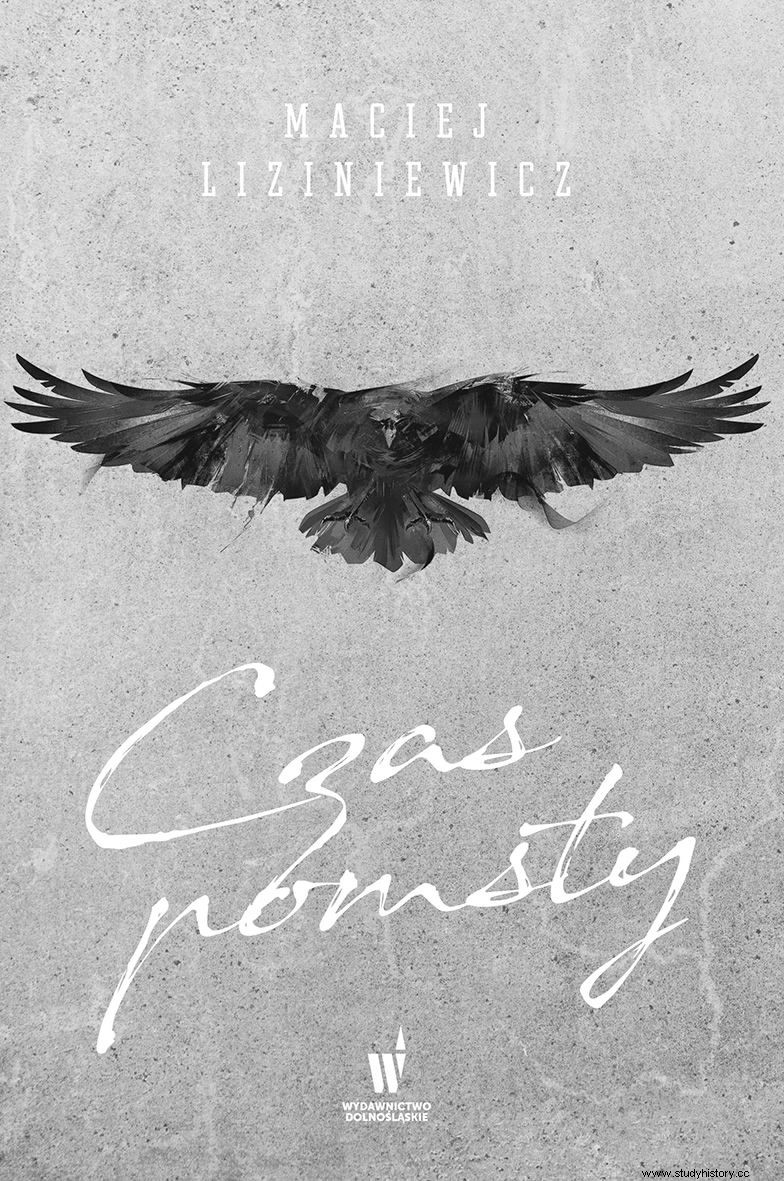
The article was inspired by the historical novel by Maciej Liziniewicz, "Czas vengeance" (Dolnośląskie Publishing House 2019).
To this should be added church trials, of which a total of 76 were held in the years 1413–1550. Interestingly, the suspects were not always accused of witchcraft as such; this category also "included" poisoning, blasphemy, practicing alchemy, defamation, and even ... impotence. How many victims of belief in witches were there? The researcher gives detailed data:
Of the 1,316 people accused of witchcraft, 558 were killed, which is 42% of the total. The courts have judged much more severely in women's trials. Among women accused of witchcraft (1,174), 535 were sentenced to death, which is about 45%. In trials against men, every sixth accused died - out of 142 accused, only 23 people (16%) were sentenced to death.
Pilaszek, however, emphasizes that "contrary to what Baranowski suggested, according to which 90% of the accused were put on the stake, the person suspected of witchcraft did not stand in a lost position and could have survived". In the case of harmless charms, lower penalties were usually imposed, such as exile, flogging, or church penance. It is worth remembering that for people of that time they were by no means light - they were associated with social ostracism and often meant a long, slow death.
The last witch in Europe
Even with a large dose of goodwill, it is difficult to call the Republic of Poland a country without heaps. Moreover, Poland also has the infamous title of the country in which the last witch on the Old Continent was burned. The crowning achievement of over three centuries of witch hunts was the execution of Barbara Zdunk, who was executed on August 21, 1811 in Reszel (now in the Warmian-Masurian Voivodeship).
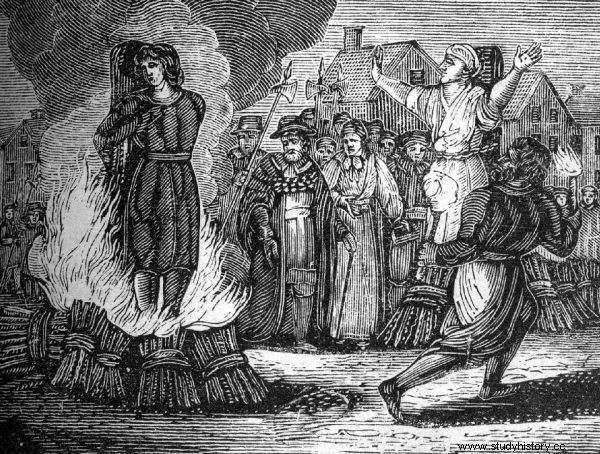
It was commonly believed that Barbara Zdunk was the last woman to be burned at the stake for allegedly engaged in witchcraft. However, there are many indications that she was condemned to the stake for a completely different reason. Illustrative illustration.
The woman was reportedly sentenced to start a fire, of course - by magic. However, Professor Jacek Wijaczka from the Institute of History and Archives of the Nicolaus Copernicus University in Toruń presents a slightly different picture of the whole situation. He argues that Barbara was not tried for magic at all, so she was burned at the stake and not because of witchcraft :
Sdunk [alternative spelling of the name - editor's note M.P.] was not accused or even accused of being a witch or practicing magic. She was tried and sentenced for setting fire to a house in which several people were burned down as a result of her act, i.e. a criminal act. The court sentenced her to be burned at the stake, having previously ordered the executioner to discreetly strangle her.
Moreover, at that time, Reszel was no longer within the borders of the Polish-Lithuanian Commonwealth. These areas had been under Prussian partition for four decades - and Barbara Zdunk was under the jurisdiction of Berlin. Its verdict was approved by King Frederick William III himself, and sorcery was not formally punished at that time.
The fact that the woman went down in history as the last witch in Europe was due to ... tradition. Well in the nineteenth century, death in flames was still strongly associated with suspicions of practicing magic (as a matter of fact, not much has changed in this regard to this day). In addition, in Reszel and the surrounding area two or three centuries earlier, women were actually tried for dealing with the devil.
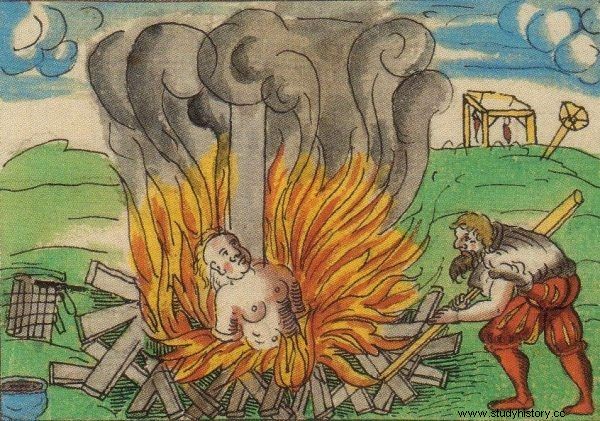
Death at the stake was, and still is, unambiguously associated with the penalty for engaging in witchcraft.
The case of Katarzyna W.
However, it was possible to "land" on the stake not only for allegedly practicing witchcraft. The death penalty in flames during the Reformation also threatened heretics. Also in this respect, our ancestors do not have a completely clear conscience, even if - as Janusz Tazbir emphasizes - in Poland the cases of executions on dissenters were marginal:
And then [in the 16th and 17th centuries - editor's note M.P.] dozens of witches or followers of Judaizantism, accused of alleged ritual murders, were burned, but only a few people paid with their heads for the very deviation from Catholicism, and only one Katarzyna Weiglowa was burned at the stake (1539). It is therefore difficult to compare these people with the victims of religious persecution in France, Germany, Spain or even England.
However, even a single stack remains a stack. And for what exactly was Katarzyna Weiglowa sentenced? Her "crime" was that ... she refused to accept Jesus as the Son of God. The woman was sentenced for a second apostasy, which was seen as converting to Judaism. According to Tazbir, the whole thing had little to do with the Reformation:
Her trial was quite loosely related to the development of Protestantism, although it is difficult to deny that by executing the Krakow townswoman, the Church wanted to remind all her supporters that she did not intend to remain indifferent to abandoning Catholicism . With respect to all other apostates, if they recalled their mistakes and made a profession of faith, they were confined to church penance or financial penalties.

The article was inspired by the historical novel by Maciej Liziniewicz, "Czas vengeance" (Dolnośląskie Publishing House 2019).
Convictions to the highest penalty and executions at the stake for one form or another of heresy did occur sporadically in the Commonwealth - but they did. Apart from Katarzyna, it is enough to mention the Cracovian Matatiasz Calahor, who was burnt in 1663 for insulting the Mother of God, or Dorota Łazęcka from Sochaczew, who allegedly stole the host in 1556 to give it to her Jewish donors.Manuscripts don't burn?
It should also not be forgotten that the piles were lit not only for people, but sometimes also for… books. The writer Serafin Gamalski, who lived at the turn of the 17th and 18th centuries, reported, for example, about the practice of buying out books describing the abuses of courts in witchcraft trials. They were then used as kindling.
In March 1689, in the Old Town Square in Warsaw, the only copy of the first Polish atheistic treaty "De non existentia Dei" was burnt - and with it its author, Kazimierz Łyszczyński . "He was one of the greatest minds of 17th-century Poland," says Andrzej Nowicki about a lost philosophy.
However, Łyszczyński's contemporaries could not appreciate his genius. Although he was not (contrary to what is commonly assumed) the first Polish atheist, and "only" the first creator of a work on this subject - it was precisely because of atheism that he was considered a heretic and sentenced to death. At the same time, strictly speaking, the thinker did not die at the stake:the executioner beheaded his head, and then the corpse was taken outside the city and only then was it released to the flames.
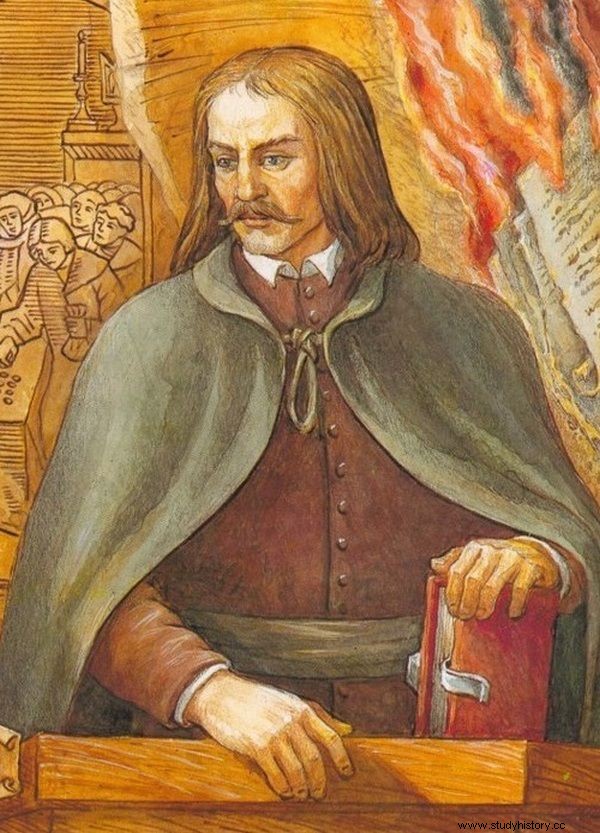
The philosopher and atheist Kazimierz Łyszczyński also finished at the stake.
Interestingly, cases of burning literature were also reported in the times of the Polish People's Republic, when censorship deemed several thousand titles obsolete or dangerous for the new system. But even if someone somewhere did set fire to several copies of the forbidden books, it was not generally practiced on a massive scale. The communist authorities approached the matter very pragmatically and suppressed hostile writing with the "method of rational management of recyclable materials" that is… by converting the book collection into waste paper.
The priests who a few months ago decided to revive the tradition from four hundred years ago did not demonstrate an equally rational attitude towards "suspicious" readings. They lit a fire, using several famous fantasy titles as kindling. As can be seen, even in the 21st century, Poland cannot be said to be a country without heaps ...
Inspiration:
The article was inspired by the historical novel by Maciej Liziniewicz, "Time of vengeance", which was published by Wydawnictwo Dolnośląskie, presenting a forgotten piece of noble Poland, where it was necessary to fight for justice with a saber in hand and where the supernatural was mixed with the real.
Bibliography:
- Bohdan Baranowski, Farewell to the devil and the witch , Łódź Publishing House 1965.
- Bohdan Baranowski, Witch trials in Poland in the 17th and 18th centuries , Lodz Scientific Society, 1952.
- Andrzej Nowicki, Lectures on the criticism of religion in Poland , Book and Knowledge 1965.
- Małgorzata Pilaszek, Trials for witchcraft in Poland in the 15th-18th centuries , Universitas 2008.
- Janusz Tazbir, A country without heaps. Sketches on the history of tolerance in Poland in the 16th and 17th centuries , Iskry 2009.
- Janusz Tazbir, The Reformation in Poland. Sketches on people and doctrine , Book and Knowledge 1993.
- Adam Węgłowski, Neither a witch, nor the last one, but a real pile , Focus.pl 12/10/2011 (accessed:19/06/2019).
Check where to buy "Time of Vengeance":
